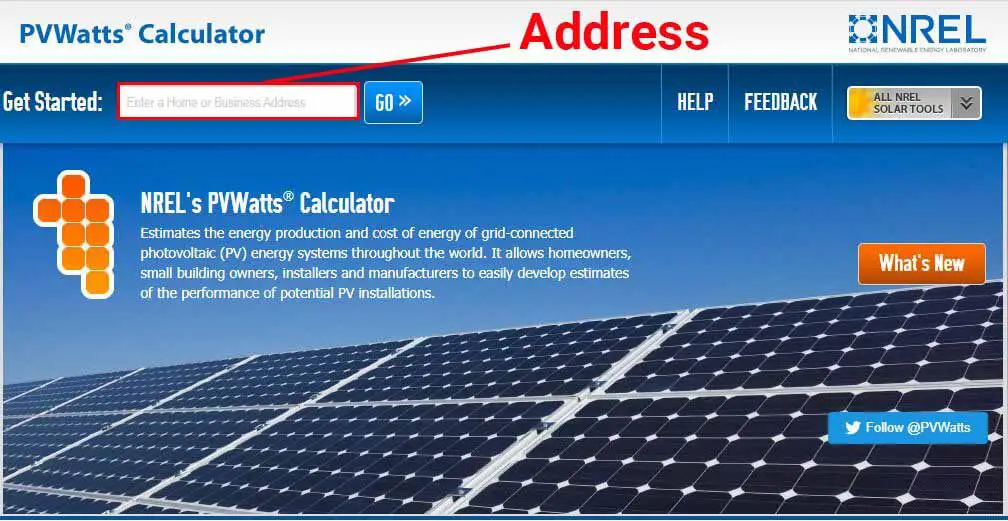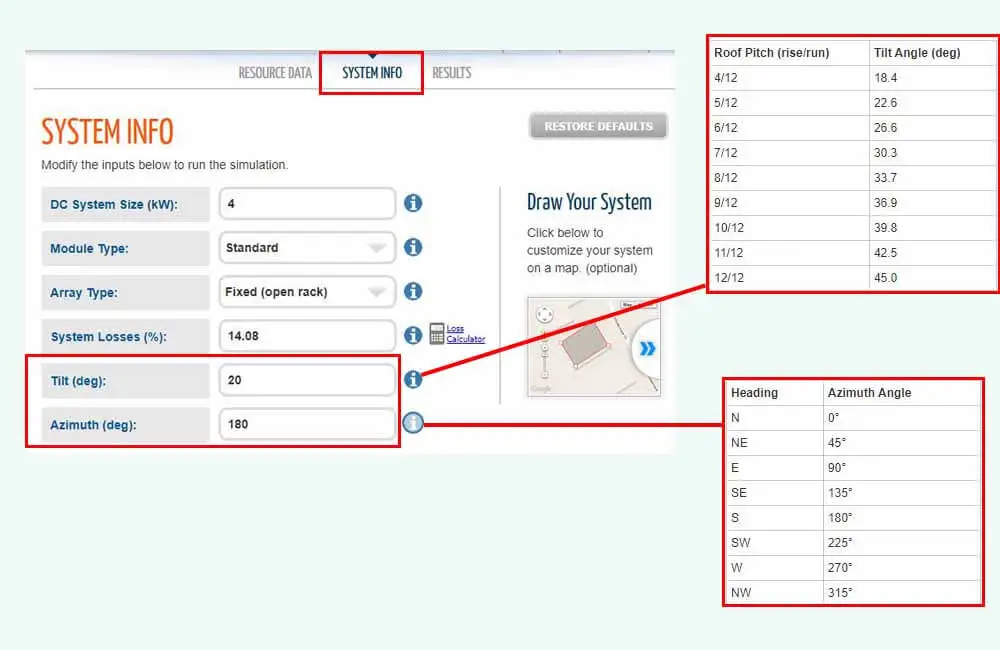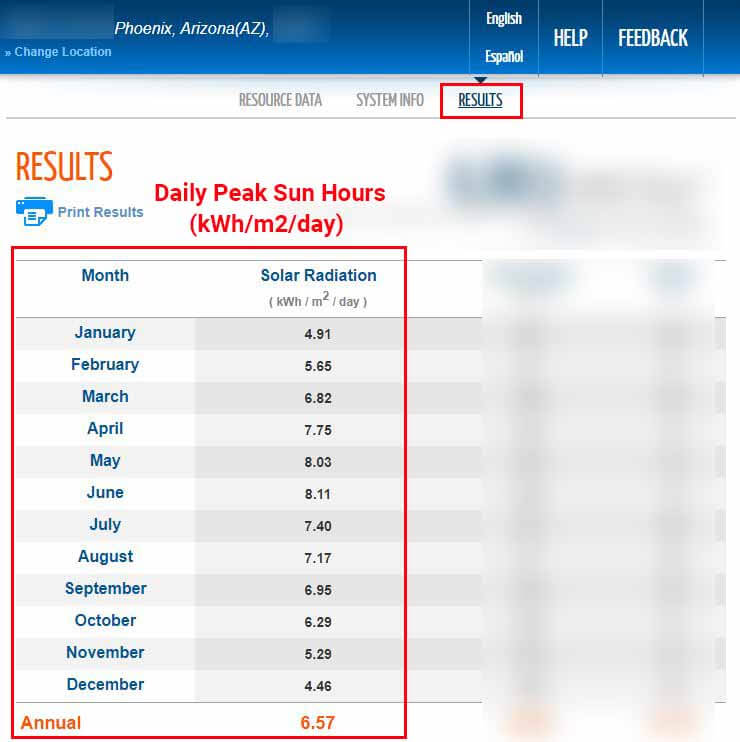There are a few factors that determine how long it would take to charge a 100Ah battery with a 200W solar panel.
In this article, I thoroughly explain these factors, and I provide a few steps that you can take to get as much of an accurate estimate as possible.
These steps are:
- Determining the amount of energy that is required to charge the battery.
- Determining the efficiency of your system.
- Determining the amount of energy that your 200W solar panel is capable of producing each day.
Before I get into these steps, the first section of this article provides a brief overview and explains why these steps are necessary.
How long to charge a 100ah battery with a 200w solar panel?
Assuming you’re using an MPPT solar charge controller, a 12V-200W solar panel would take 10 to 20 daytime hours to charge a completely depleted 12V-100Ah battery. However, if you’re using a PWM charge controller, it would take a 12V-200W solar panel 12 to 24 daytime hours to charge a completely depleted 12V-100Ah battery.
During these daytime hours, the actual amount of sunlight your solar panel receives would fluctuate, and so would the amount of power your solar panel generates.
In other words, the 200W solar panel will only really produce 200 watts of power under certain conditions, and when those conditions aren’t met, the solar panel would produce less than 200 watts.
For example, in the morning, when the sun is closer to the horizon, the amount of sunlight a 200W solar panel receives is very low, and it might only produce 30-50 watts of power.
However, at noon, when the sun is directly above the solar panel, a 200W solar panel might produce 170-200 watts of power. This is, of course, assuming the sky is perfectly clear.
But what does this mean?
Well, if a solar panel produced a constant 200 watts of power (or any constant amount of power), it would be very easy to determine the amount of time it would take for it to produce a certain amount of energy.
For example, a battery that is rated at 12V (Volts) and 100Ah (Amp-hours), is capable of storing 1200 Watt-hours of energy:
Rated Energy Capacity (Watt-hours) = Rated Battery Voltage (Volts) x Rated Charge Capacity (Amp-hours)
Rated Energy Capacity (Watt-hours) = 12V x 100Ah
Rated Energy Capacity (Watt-hours) = 1200Wh
If, for example, our 200W solar panel produced a constant 200 watts of power, and assuming our system is 100% efficient, we could easily calculate the amount of time it would take for it to generate 1200Wh of energy:
Required Time (hours) = Required Energy (Watt-hours) ÷ Power Production (Watts)
Required Time (hours) = 1200 Watt-hours ÷ 200 Watts
Required Time (hours) = 6 hours
But the amount of power a 200W solar panel produces will fluctuate depending on the amount of sunlight it has access to. And these fluctuations make it almost impossible to get accurate predictions.
However, what you could do instead, is determine the average amount of energy that your 200W solar panel should produce on a daily basis, and use that to get some rough estimates. This can be done using historical Solar Irradiation data provided by the National Renewable Energy Laboratory (NREL).
Before I explain how you can do that, we should first discuss the amount of energy that your 100Ah battery requires to charge.
Step 1: How much energy (Wh) does your 100Ah battery require to charge?
Batteries are given 2 main ratings:
- Voltage (V): 12V for example
- Amp-hours (Ah): 100Ah in this case
To determine the Rated Energy Capacity of your battery (in Watt-hours), simply multiply its Rated Voltage (V) by its Rated Amp-hours (Ah):
Rated Energy Capacity of the battery (Watt-hours) = Rated Voltage (V) x Rated Amp-hours (Ah)
For example, if your 100Ah battery is rated at 12 Volts, its rated energy capacity is 1200Wh (12V x 100Ah). And what this means is that at a 100% state of charge, your battery holds 1200 Watt-hours of energy.
So if your 12V-100Ah battery is completely depleted (0% state of charge), your 200W solar panel will need to produce 1200 Wh of energy or more (depending on charge controller efficiency) to charge your battery.
However, if your 100ah battery is a Lead-Acid battery, and you’re only using 50% of its capacity (which you should), the battery will only go as low as 50% state of charge. In this case, a 12V-100Ah battery will only require 600Wh of energy to fully charge.
To determine how much energy your battery needs to charge, simply multiply the rated energy capacity of the battery by the Depth Of Discharge (DOD) you’re using:
Amount of energy required to charge the battery (Watt-hours) = Rated Energy Capacity (Watt-hours) x Depth Of Discharge (%)
For example, if you’re using a 12V-100Ah Lithium battery at a depth of discharge of 80%, the amount of energy that the battery needs to charge is:
Amount of energy required to charge the battery (Watt-hours) = Rated Energy Capacity (Watt-hours) x Depth Of Discharge (%)
Amount of energy required to charge the battery (Watt-hours) = 1200 Wh x 80%
Amount of energy required to charge the battery (Watt-hours) = 1200 Wh x 0.8
Amount of energy required to charge the battery (Watt-hours) = 960 Wh
Whichever the case is, what we’ve just discussed is the amount of energy that the battery requires to charge. But what we really need, is the amount of energy that the solar panel is required to produce.
But, what’s the difference?
Well, solar panels charge batteries through solar charge controllers, and just like any electronic device, these charge controllers are never 100% efficient.
This means that a percentage of the energy that the 200W solar panel produces will be lost, which in turn means that the solar panel will have to produce more energy to offset these losses.
For example, if your 100Ah battery requires 600Wh of energy to charge, and your system is only 75% efficient, your 200W solar panel will have to produce 800Wh of energy (600Wh ÷ 75%) instead of 600Wh.
These losses and inefficiencies will mainly depend on the type of solar charge controller you’re using.
This brings us to the next step.
Step 2: How efficient is your solar charge controller?
There are 2 types of solar charge controllers you might be using:
- A PWM (Pulse Width Modulation) charge controller
- Or an MPPT (Maximum Power Point Tracking) charge controller
Here are some pages where you can learn more about solar charge controllers:
What is a solar charge controller?
MPPT charge controller calculator
PWM charge controller calculator
In the meantime, what you need to know is that there’s generally a big difference in efficiency between these 2 types of charge controllers, MPPTs being the most efficient, and PWM charge controllers being the least efficient.
The efficiency of a PWM solar charge controller will depend on the difference between the voltage of the solar panel and the voltage of the battery, the bigger the difference, the less efficient the PWM charge controller is.
In general, if you’re using a PWM charge controller, you’ll be looking at 75% efficiency.
On the other hand, MPPT charge controllers have an efficiency of about 98%.
For example, if your solar panel manages to produce 1000Wh of energy per day, and you’re using a PWM charge controller, only 75% of that energy (750Wh) will make it to the battery. And if you’re using an MPPT charge controller, 98% of that energy (980Wh) gets to the battery.
Amount of Energy that makes it to the battery (Watt-hours) = Solar Panel Energy Production (Watt-hours) x Charge Controller Efficiency (%)
We know how much energy the 100Ah battery needs to charge, and we now have an idea about how efficient these solar charge controllers are. Using the following formula, we can determine how much energy we need the solar panel to produce:
Required Energy Production (Watt-hours) = Amount of energy required to charge the battery (Watt-hours) ÷ Charge Controller Efficiency (%)
For example, consider the following system:
- 200W solar panel
- 20A MPPT charge controller
- 12V-100Ah Lithium battery.
Lithium batteries can be fully discharged, and to take a 12V-100Ah lithium battery from a 0% state of charge to a 100% state of charge, you would need 1200 Watt-hours of energy (12V x 100Ah).
As discussed above, MPPT charge controllers are around 98% efficient.
Using our formula, this is how much energy we would need the 200W solar panel to produce:
Required Energy Production (Watt-hours) = Amount of energy required to charge the battery (Watt-hours) ÷ Charge Controller Efficiency (%)
Required Energy Production (Watt-hours) = 1200 Watt-hours ÷ 98%
Required Energy Production (Watt-hours) = 1200 Watt-hours ÷ 0.98
Required Energy Production (Watt-hours) = 1224 Watt-hours
Now, what we need to find out is how long is it going to take for our 200W solar panel to produce that amount of energy.
As discussed above, the best way to go about this is to first determine the average amount of energy that your 200W solar panel would produce each day. This brings us to the next and last step.
Step 3: How much energy will your 200W solar panel produce each day?
A 200W solar panel can produce anywhere from 600 to 1600 Watt-hours of energy per day. The exact amount of energy (Watt-hours) a solar panel generates in a day, would depend on the location, the weather conditions of that particular day, and the orientation of the solar panel.
However, as mentioned before, you can use historical data to estimate the average daily energy production of your 200W solar panel for a particular month, using your location, the tilt angle, and the direction the solar panel is facing.
Before I show you how to do that, let me explain a few basics.
Solar panel power rating, Peak Sun Hours (PSH), and energy production:
When a manufacturer rates a solar panel at certain Wattage, they give that rating based on 3 standard test conditions (STC):
- A Solar Irradiance of 1000W/m² (Watts per square meter), which is equivalent to a sunny day.
- A temperature of 77°F (25°C).
- An air mass equal to 1.5.
For simplicity, we’ll just focus on the 1st test condition which is solar irradiance.
For example, if the sky is clear and your 200W solar panel receives 1000W/m² of solar irradiance, it will produce 200 Watts of power. If the sky is somewhat cloudy and the solar panel only receives 600W/m² of solar irradiance, it will only produce 60% of its rated output (120 Watts).
Since we can deduce how much power a solar panel can produce based on its rating and how much solar irradiance it receives, we can also determine how much energy the solar panel generates based on its rating and how much energy it has received from the sun over a certain period of time.
This amount of sunlight energy that a solar panel receives over a certain period of time, is measured in kWh/m² (kilo-Watt-hours per square meter) and is referred to as Peak Sun Hours.
Combined with the rating of the solar panel, these Peak Sun Hours (PSH) can be used to calculate how much energy the solar panel produces over time:
Energy Production (Watt-hours) = Power Rating (Watts) x Peak Sun Hours (hours)
For example, if our 200W solar panel receives 4.5 kWh/m² (4500 Wh/m²) of sunlight energy per day, it could be said that the solar panel receives 4.5 Peak Sun Hours per day, and its daily energy production can be calculated as such:
Daily Energy Production (Watt-hours) = Power Rating (Watts) x Daily Peak Sun Hours (hours)
Daily Energy Production (Watt-hours) = 200 Watts x 4.5 hours
Daily Energy Production (Watt-hours) = 900 Watt-hours
So, in order to estimate the daily energy production of your 200W solar panel, all you need is an estimate of the daily Peak Sun Hours that you get.
So, how many Peak Sun Hours do you get each day?
Thanks to PVWatts Calculator, you can easily determine the monthly average number of Peak Sun Hours that you get on a daily basis. All you have to do is submit your address, along with a couple of details that describe your setup.

For example, I used an address in Phoenix, AZ, and under the “System Info” section of the tool, I submitted the following:
- The solar panel is titled at a 20° angle
- The solar panel is facing South (180° Azimuth)
Since we’re only looking for Peak Sun Hours, unless your solar panel is equipped with a solar tracker, the other fields in the “System Info” section are not really relevant here.

Once I submitted the tilt angle and the Azimuth, I went to the “Results” of the tool, and the PVWatts Calculator provided the following results:

In the table, you can see different Peak Sun Hours values for each month, and an annual average number of Peak Sun Hours, all measured in kWh/m²/day.
For example, in the month of January, in this particular location and with this particular setup, our solar panel would – on average – receive 4.91 Peak Sun Hours per day.
So, if our solar panel is rated at 200W, and it – on average – receives 4.91 Peak Sun Hours a day in January, we could calculate the average amount of energy that our solar panel produces each day (in January) as such:
Daily Energy Production in January (Watt-hours) = Power Rating (Watts) x Daily Peak Sun Hours in January (hours)
Daily Energy Production in January (Watt-hours) = 200 Watts x 4.91 hours
Daily Energy Production in January (Watt-hours) = 982 Watt-hours
In June for example, our solar panel would receive 8.11 Peak Sun Hours per day, and its average daily energy production would be much higher than that of January:
Daily Energy Production in June (Watt-hours) = Power Rating (Watts) x Daily Peak Sun Hours in June (hours)
Daily Energy Production in June (Watt-hours) = 200 Watts x 8.11 hours
Daily Energy Production in June (Watt-hours) = 1622 Watt-hours
Now, again, these are just estimates based on historical data, but they are still the most accurate predictions that you could get.
In any case, once you determine how much energy you need the solar panel to produce, and how much energy it is capable of producing each day, you can do a quick research on how many daytime hours there are in that particular month in your location, and use the following formula to determine how long it would for the 200W solar panel to charge your 100Ah battery:
Daytime hours required (hours) = (Required Energy production (Watt-hours) ÷ Daily Energy Production (Watt-hours)) x Daytime hours in each day
To get a better understanding of this, let’s look at a couple of examples.
Examples
Example 1:
For this example, Let’s make the following assumptions:
- We need our solar panel to produce 1224 Wh of energy to fully charge our 12V-100Ah Lithium battery.
- Our 200W solar panel is capable of producing 1622 Wh of energy per day in June.
- Day length in June in our particular location is around 14 hours.
Using our formula, we can estimate the number of daytime hours that our 200W solar panel needs to charge our 100Ah battery:
Daytime hours required (hours) = (Required Energy production (Watt-hours) ÷ Daily Energy Production (Watt-hours)) x Daytime hours in each day
Daytime hours required (hours) = (1224 Watt-hours ÷ 1622 Watt-hours) x 14 hours
Daytime hours required (hours) = (0.75) x 14 hours
Daytime hours required (hours) = 10.5 hours
So, in our particular location (somewhere in Phoenix, AZ), and in the month of June, a South-facing 200W solar panel that is tilted at a 20-degree angle, can charge a completely discharge 12V-100Ah Lithium battery in 10 hours and 30 minutes.
Example 2:
For this 2nd example, Let’s make the following assumptions:
- We need our solar panel to produce 1224 Wh of energy to fully charge our 12V-100Ah Lithium battery.
- Our 200W solar panel is capable of producing 982 Wh of energy per day in January.
- Day length in January in our particular location is around 10 hours.
Using our formula, we can estimate the number of daytime hours that our 200W solar panel needs to charge our 100Ah battery:
Daytime hours required (hours) = (Required Energy production (Watt-hours) ÷ Daily Energy Production (Watt-hours)) x Daytime hours in each day
Daytime hours required (hours) = (1224 Watt-hours ÷ 982 Watt-hours) x 10 hours
Daytime hours required (hours) = (1.24) x 10 hours
Daytime hours required (hours) = 12.4 hours
So, in our particular location (somewhere in Phoenix, AZ), and in the month of January, a South-facing 200W solar panel that is tilted at a 20-degree angle, can charge a completely discharge 12V-100Ah Lithium battery in 12 hours and 25 minutes.
In this particular case, since the number of daytime hours that we need is more than the daytime hour available each day, we would actually need a day and a few hours.
Related Topics:
What can a 200w solar panel power?
Do solar panels work on cloudy days?
Do solar panels need direct sunlight to work?
How long will a 100Ah battery last?
How long will a 100Ah battery run a TV?
How long will a 100Ah battery run a refrigerator?

